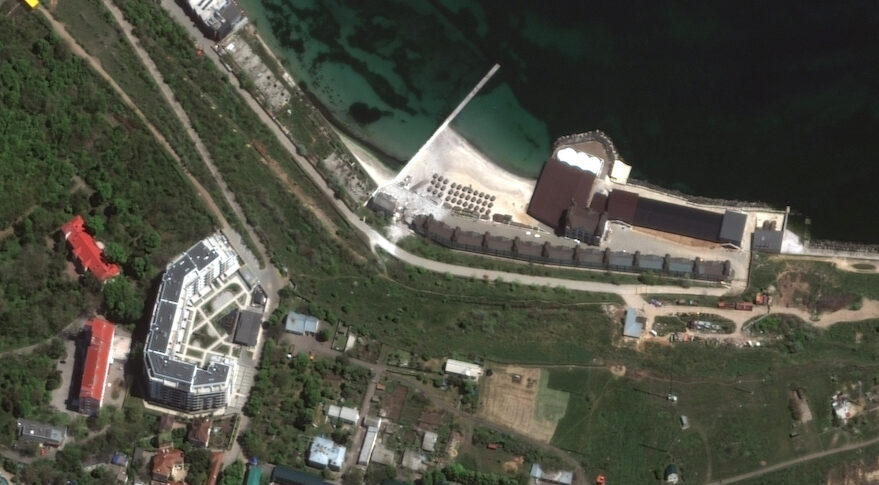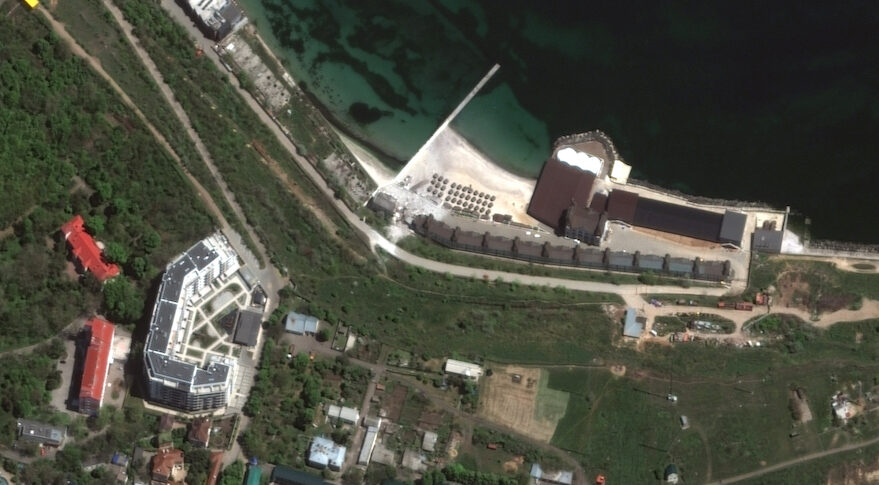
Jim Reilly is a former NASA astronaut and current executive adviser at Booz Allen Hamilton. Chris Bogdan is Booz Allen’s senior vice president for the firm’s aerospace business.
While our space assets orbit the Earth hundreds of miles above, the invasion of Ukraine has shown that the space domain is not above deteriorating geopolitical conditions. In fact, the ongoing conflict has further solidified the critical role of space in modern warfighting and national security, highlighting that data collected from space assets is mission-critical for U.S. intelligence and defense operations—in addition to its ability to illustrate a clear picture of the situation to the public. In the past, most space-based overhead imagery, communications and data related to national security were provided by U.S. government or allied government systems. However, over the last two decades, commercial providers have expanded their capabilities to now provide services and data to the government that was, in the past, only provided by national systems. The conflict in Ukraine has shown us that we must now protect and make both our government and commercial space assets more resilient.
The role of satellites in maintaining information dominance
Success in modern warfare is critically dependent on maintaining an information advantage over adversaries. Space-derived information and services such as imagery, communications, environmental characterization, electronic intelligence, and weapons warning and tracking are vital for a global power like the U.S. Without these overhead systems, continuous monitoring of threats and events throughout the world would not be possible. The importance of these persistent global “eyes” and “ears” was on full display before the invasion of Ukraine. The U.S. was able to discern the nature and location of the Russian military buildup, determine quantities and locations of fuel reserves, and identify portable hospital stations carrying blood supplies around the border of Ukraine—leading to the correct understanding that an invasion was imminent. As the invasion commenced, and every day since, both commercial and national space-based assets are tracking and characterizing events on the ground with significant accuracy.
Because these space assets provide crucial value to our understanding of what is going on in most conflicts, we must assume that they are going to be under threat of both kinetic and non-kinetic attack by our adversaries, and we must develop ways to make these systems more resilient. An example of the primary non-kinetic threat was recently illustrated by the report of a successful attack on a commercial communications satellite at the beginning of the Russia-Ukraine war. With the relatively low cost of acquisition, the reduced probability of attribution, and the generally high level of success, cyber threats will continue to expand. Cybersecurity requirements and standards for commercial systems will need to be upgraded to meet the expanding threat. Kinetic threats, primarily anti-satellite weapons, are more expensive, much harder to deny when employed and create clouds of additional orbital debris, putting everyone’s satellites at risk.
Leveraging data fabrics, edge processing and other innovative tech to ensure satellite resiliency
Space systems today are critical to global military operations, economic well-being, and our way of life. The potential repercussions of compromised space systems would be catastrophic. We must move away from singular satellites that are “big, fat, juicy targets,” as Gen. John Hyten, former vice chairman of the Joint Chiefs of Staff, once famously described, and deploy resilient systems of multiple satellites. In addition, the ground systems that control and communicate with our satellites must be made more resilient. One way of doing this is to put more of the data and control systems on the satellites themselves. Another is to deliver the command, control and communications of constellations across a self-healing mesh network. A key advantage of such a network — currently exemplified by SpaceX’s Starlink satellite constellation for internet access coverage — lies in its connectivity across an infrastructure spread over hundreds of satellites. This technique of disaggregation, along with a cross-linked, healing network, creates a resilient constellation where no single satellite or link will render the entire system useless.
Other advanced technologies can also drive further resilience into these space systems. By implementing modern open data and software architectures, it will be possible to rapidly update satellite and network capabilities in near real-time, adapting them to the changing threat environment. With the advent of high-capacity onboard edge processing coupled with artificial intelligence (AI) and data analytics, we can create constellations of “smart” satellites which can flexibly and quickly respond to mission changes. Edge processing also reduces the volume of data needed to be downlinked, which mitigates some of the risks of disruption of the data flow, simplifies the communications infrastructure, reduces the need for ground processing, and enhances the speed of delivery of actionable intelligence. To rapidly field these new technologies, the federal government should leverage commercial industry innovation and source expertise from private industry for more agile development and deployment.
Strategic partnerships between government and commercial sectors
Commercial use of space technology is not new, and the rise in both federal and commercial activity poses opportunities for rapid innovation in driving forward the next generation of warfare. As the government operates in an increasingly data-centric environment, swift deployment of mission-based solutions, open architectures and government-owned APIs will allow the Defense Department to integrate technology from traditional vendors and non-traditional technology innovators. Open data platforms running on interoperable systems can also enable intelligence and military leaders to avoid vendor lock-in and allow for rapid upgrading and injection of new capabilities keeping pace with our adversaries who are heavily investing in advanced digital warfare technology.
In terms of partnerships between the public and private sectors, existing commercial assets such as the Starlink satellite network can bolster the intelligence community’s information advantage and expand key communications around areas of conflict. Additionally, capabilities like AI and machine learning (ML) are already common within the intelligence community – but taken a step further, military and federal agencies can harness AI capabilities such as anomaly detection that may point toward adversary action, or rapid recovery of mesh communications within a satellite constellation, to ensure consistent uptime. AI combined with ML also provides an ability for battlespace characterization where multiple sources of information, both satellite and ground, can learn to recognize anomalies likely associated with hostile actions by our adversaries.
Additionally, changes in the space environment—popularly known as space weather—affect the orbits of satellites we depend on. This effect, combined with intentional shifts in satellite positions and ever-expanding volumes of orbital debris, increase threat vectors in the form of collisions. We need a better forecast capability for changes in these trajectories in response to solar storms to minimize the potential for collisions in the increasingly crowded low Earth orbits where most of our information collection systems operate. This will require new sensors to more precisely measure and model changes in the environment, how those changes affect orbits and where the threats of collisions will exist. AI-powered predictive analysis can also be leveraged for space traffic management to include courses of action for maneuvering satellites, i.e., international “rules of the road.”
While the information advantage of space-based assets has been highlighted by the ongoing war in Ukraine, the need for satellite resiliency is not limited to times of conflict or active warfare. Many near-peer adversaries have prioritized space capabilities. The increasingly competitive nature of space means that U.S. and allied assets are at continuous risk from both kinetic and non-kinetic threats. Creating more resilient government and commercial space systems is absolutely necessary to ensure we maintain military advantage anywhere on the globe.

